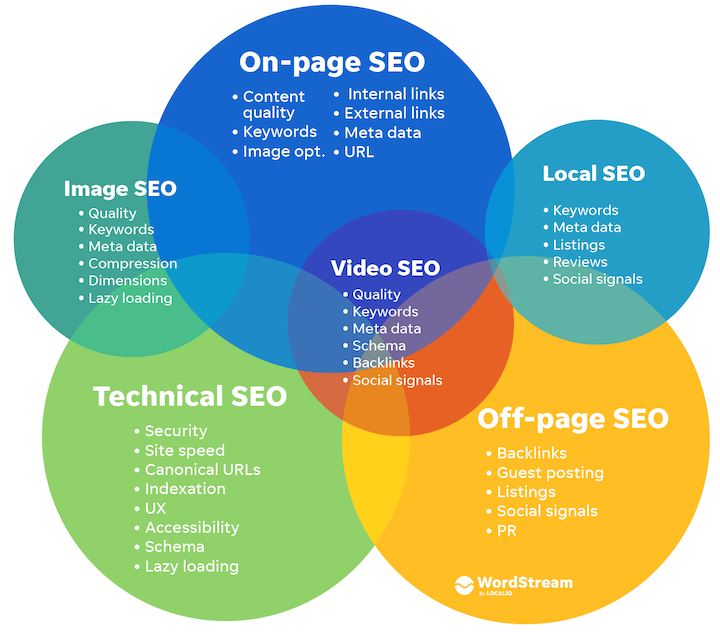Search Engine Optimization (SEO) is a multifaceted digital marketing discipline that plays a pivotal role in enhancing online visibility and attracting organic traffic.
While the ultimate goal of all SEO efforts is to improve search engine rankings, there are various strategies and approaches that can be categorized into different types of SEO.
In this comprehensive article, we’ll delve into the diverse spectrum of SEO, exploring the various types, their purposes, and the scenarios in which they are most effective.
1. On-Page SEO
On-Page SEO refers to the practice of optimizing individual web pages to improve their search engine rankings. It involves several key elements:
- Keyword Optimization: Researching and incorporating relevant keywords into the content, title, headings, and meta descriptions.
- Quality Content: Providing high-quality, engaging, and informative content that adds value to the user.
- Title Tags and Meta Descriptions: Crafting compelling titles and meta descriptions that encourage clicks.
- Header Tags: Using header tags (H1, H2, H3, etc.) to structure the content and make it more accessible.
- Image Optimization: Optimizing images with descriptive alt text and proper file names.
- Internal Linking: Linking to other relevant pages within your website.
- URL Structure: Creating clean and user-friendly URLs.
On-Page SEO is the foundation of any successful SEO strategy, as it focuses on optimizing the individual elements of your web pages to make them more search engine-friendly.
2. Off-Page SEO
Off-Page SEO involves optimizing elements outside your website to improve your search engine rankings. Key elements of Off-Page SEO include:
- Link Building: Acquiring high-quality backlinks from authoritative websites in your niche. Backlinks from trusted sources can significantly boost your website’s credibility and ranking.
- Social Signals: Engaging with your audience on social media and sharing your content can indirectly influence your search engine rankings.
- Online Reputation Management: Monitoring and managing your online reputation to build trust and authority in your niche.
Off-Page SEO is crucial for building authority and credibility in the eyes of search engines.
3. Technical SEO
Technical SEO focuses on the technical aspects of your website that impact its search engine rankings. These include:
- Crawlability: Ensuring that search engines can access and crawl your website’s content.
- Site Speed: Optimizing your website for fast loading times, which is crucial for user experience and ranking.
- Mobile-Friendliness: Ensuring that your website is responsive and user-friendly on mobile devices.
- Schema Markup: Implementing structured data to help search engines better understand your content.
- Canonical Tags: Specifying the preferred version of a web page when duplicate content exists.
Technical SEO is the backbone of your SEO strategy and sets the stage for on-page and off-page optimization.
4. Local SEO
Local SEO is essential for businesses that serve specific geographic areas. It involves optimizing your online presence to attract local customers. Key components of local SEO include:
- Google My Business: Claiming and optimizing your Google My Business listing to appear in local search results.
- Local Citations: Ensuring your business information is consistent across online directories and listings.
- Online Reviews: Encouraging and managing customer reviews, which can impact your local rankings.
- Local Content: Creating content that targets local keywords and addresses the needs of local customers.
Local SEO helps businesses establish a strong presence in their local markets and attract nearby customers.
5. E-Commerce SEO
E-commerce SEO is tailored for online retailers and focuses on optimizing product pages and categories. Key aspects include:
- Product Descriptions: Writing compelling and unique product descriptions.
- Product Images: Optimizing images for product listings.
- User Reviews: Encouraging customer reviews for social proof and SEO benefits.
- Structured Data: Implementing structured data to enhance the visibility of product listings in search results.
E-commerce SEO is essential for driving organic traffic to product pages and increasing conversions.
6. Voice Search SEO
With the rise of voice-activated devices and virtual assistants, optimizing for voice search is becoming increasingly important. Voice search SEO involves:
- Natural Language Keywords: Targeting conversational and long-tail keywords.
- Featured Snippets: Optimizing content for featured snippets, as they are often used for voice search responses.
- Local Optimization: Ensuring that your business appears in local voice searches.
Voice search SEO is essential for staying ahead in the age of smart speakers and virtual assistants.
7. Video SEO
Video SEO focuses on optimizing video content for search engines and video-sharing platforms like YouTube. Key strategies include:
- Keyword Research: Finding relevant keywords for video content.
- Video Titles and Descriptions: Crafting compelling titles and descriptions.
- Video Transcripts: Providing written transcripts to make video content accessible and searchable.
- Engagement and Sharing: Encouraging audience engagement and sharing to boost video visibility.
Video SEO is crucial for reaching a broader audience through video content.
Conclusion
Understanding the different types of SEO is essential for tailoring your digital marketing strategy to your specific goals and audience. Each type of SEO serves a unique purpose, and the most effective approach for your website or business will depend on your objectives and target audience.
By incorporating the right mix of these SEO types into your strategy, you can optimize your online presence, improve search engine rankings, and drive organic traffic to achieve your digital marketing goals.
Whether you’re focused on e-commerce, local visibility, or enhancing user experience, there’s an SEO type to match your needs in the ever-evolving world of digital marketing.
